Following is a roundup of news and commentary on the Pope's visit to Rome's Jewish community.
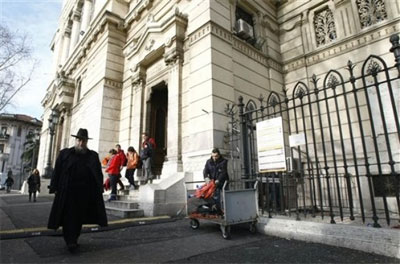
Roundup 2 (Post-visit)
- Via Catholic News Service, the English translation of Pope Benedict's address
... The teaching of the Second Vatican Council has represented for Catholics a clear landmark to which constant reference is made in our attitude and our relations with the Jewish people, marking a new and significant stage. The Council gave a strong impetus to our irrevocable commitment to pursue the path of dialogue, fraternity and friendship, a journey which has been deepened and developed in the last forty years, through important steps and significant gestures. Among them, I should mention once again the historic visit by my Venerable Predecessor to this Synagogue on 13 April 1986, the numerous meetings he had with Jewish representatives, both here in Rome and during his Apostolic Visits throughout the world, the Jubilee Pilgrimage which he made to the Holy Land in the year 2000, the various documents of the Holy See which, following the Second Vatican Council’s Declaration Nostra Aetate, have made helpful contributions to the increasingly close relations between Catholics and Jews. I too, in the course of my Pontificate, have wanted to demonstrate my closeness to and my affection for the people of the Covenant. I cherish in my heart each moment of the pilgrimage that I had the joy of making to the Holy Land in May of last year, along with the memories of numerous meetings with Jewish Communities and Organizations, in particular my visits to the Synagogues of Cologne and New York.
Furthermore, the Church has not failed to deplore the failings of her sons and daughters, begging forgiveness for all that could in any way have contributed to the scourge of anti-Semitism and anti-Judaism (cf. Commission for Religious Relations with the Jews, We Remember: A Reflection on the Shoah, 16 March 1998). May these wounds be healed forever! The heartfelt prayer which Pope John Paul II offered at the Western Wall on 26 March 2000 comes back to my mind, and it calls forth a profound echo in our hearts: “God of our Fathers, you chose Abraham and his descendants to bring your Name to the nations: we are deeply saddened by the behaviour of those who in the course of history have caused these children of yours to suffer, and asking your forgiveness we wish to commit ourselves to genuine brotherhood with the people of the Covenant.”
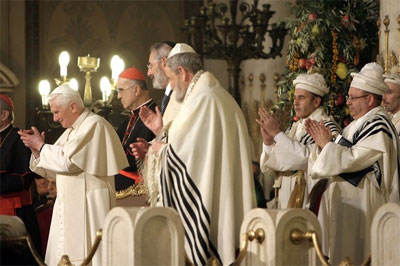 Pope Benedict XVI (L) visits the Synagogue of Rome on January 17, 2010 in Rome, Italy. Credit: Getty Images
Pope Benedict XVI (L) visits the Synagogue of Rome on January 17, 2010 in Rome, Italy. Credit: Getty ImagesThe passage of time allows us to recognize in the Twentieth Century a truly tragic period for humanity: ferocious wars that sowed destruction, death and suffering like never before; frightening ideologies, rooted in the idolatry of man, of race, and of the State, which led to brother killing brother. The singular and deeply disturbing drama of the Shoah represents, as it were, the most extreme point on the path of hatred that begins when man forgets his Creator and places himself at the centre of the universe. As I noted during my visit of 28 May 2006 to the Auschwitz Concentration camp, which is still profoundly impressed upon my memory, “the rulers of the Third Reich wanted to crush the entire Jewish people”, and, essentially, “by wiping out this people, they intended to kill the God who called Abraham, who spoke on Sinai and laid down principles to serve as a guide for mankind, principles that remain eternally valid” (Discourse at Auschwitz-Birkenau Concentration Camp: The Teachings of Pope Benedict XVI, II, 1 [2006], p.727).
Here in this place, how could we not remember the Roman Jews who were snatched from their homes, before these very walls, and who with tremendous brutality were killed at Auschwitz? How could one ever forget their faces, their names, their tears, the desperation faced by these men, women and children? The extermination of the people of the Covenant of Moses, at first announced, then systematically programmed and put into practice in Europe under the Nazi regime, on that day tragically reached as far as Rome. Unfortunately, many remained indifferent, but many, including Italian Catholics, sustained by their faith and by Christian teaching, reacted with courage, often at risk of their lives, opening their arms to assist the Jewish fugitives who were being hunted down, and earning perennial gratitude. The Apostolic See itself provided assistance, often in a hidden and discreet way.
The memory of these events compels us to strengthen the bonds that unite us so that our mutual understanding, respect and acceptance may always increase. ... [Read the rest]
- From Zenit News:
The Pope arrived around 5:25 this evening and was welcomed by a group including the president of the Jewish Community of Rome, Riccardo Pacifici; the president of the Union of Italian Jewish Communities, Renzo Gattegna; and by the Chief Rabbi of Rome, Riccardo Di Segni.
Before entering the synagogue, the Holy Father placed flowers before memorial tablets that record two of the darkest moments in the history of the Jewish Community of Rome: one commemorating the round-up and deportation of 1,022 Jews on Oct. 16, 1943; the other marking the Oct. 9, 1982, terrorist attack on the Tempio Maggiore, in which a two-year-old child was killed, and more than 40 others were injured.
Benedict XVI, the second Pope to visit the Synagogue of Rome -- John Paul II being the first in 1986 -- was the first Pontiff to pause before the memorial tablet for the child. He placed a vase of white flowers there. He also greeted the relatives of the murdered child and the injured who survived the attack, among whom was Emanuele Pacifici, the father of the president of the Jewish Community of Rome.
Red flowers were placed before the tablet recalling the 1943 deportation.
 As anticipated, John Allen Jr. reports that tensions over Pius XII surface in pope's synagogue visit:
As anticipated, John Allen Jr. reports that tensions over Pius XII surface in pope's synagogue visit:“The silence of Pius XII on the Holocaust is still painful,” said Riccardo Pacifici, head of the Jewish Community of Rome, in his remarks to Benedict XVI.
“Perhaps he could not have stopped the trains of death, but he could have transmitted a signal, a final word of comfort, for our brothers on their way to the camps of Auschwitz,” Pacifici said.
Pacifici also called upon the Vatican to open its archives from the era of Pius XII. While the Vatican has already published multiple volumes of material which it asserts contain everything relevant to the pope’s conduct during the war years, other material has not yet been unsealed.
Rome’s Chief Rabbi, Riccardo Di Segni, was more indirect, but no less clear in his reference to Pius XII.
“The silence of God about the evils of the world, or our inability to hear his voice, is an inscrutable mystery,” Di Segni said. “But the silence of man is a different matter. It confronts us, it challenges us, and it does not escape judgment.”
In his speech, Benedict XVI issued what amounted to a veiled defense of his controversial predecessor.
Benedict noted that the Nazi campaign to exterminate Jews reached as far as Rome, and conceded that “unfortunately, many remained indifferent.”
“But many, including Italian Catholics, sustained by their faith and by Christian teaching, reacted with courage, often at risk of their lives, opening their arms to assist the Jewish fugitives who were being hunted down, and earning perennial gratitude,” the pope said.
Benedict then added: “The Apostolic See itself provided assistance, often in a hidden and discreet way.”
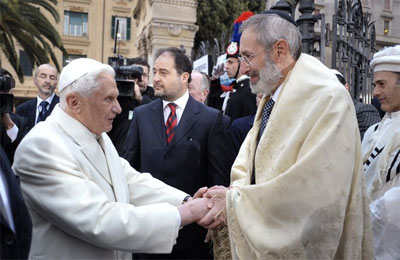
Roundup 1 (Preliminary)
- From Zenit, the official program for Pope Benedict's Sunday Trip to Synagogue.
- The Pope also visited the Jewish Museum of the Eternal City:
For the occasion, the museum has organized an exhibit called "Et Ecce Gaudium": The Jews of Rome and the Investiture Ceremony of the Popes." The exhibit will present to the public panels dating from the 1700s that had been thought lost. ...
The display will show paintings and documents that explain the role of Rome's Jewish community for the investiture ceremonies of the popes of the 1700s.
More historical details on Jewish participation in the "investiture ceremonies" and the Museum's exhibit, from Catholic News Service:
The centerpiece of the exhibit is comprised of 14 decorative panels made by Jewish artists to mark the inauguration of the pontificates of Popes Clement XII, Clement XIII, Clement XIV and Pius VI in the 1700s.
For hundreds of years, the Jewish community was obliged to participate in the ceremonies surrounding the enthronement of new popes -- often in a humiliating manner.
Various groups in the city were assigned to decorate different sections of the pope's route between the Vatican and the Basilica of St. John Lateran. The Jewish community was responsible for the stretch of road between the Colosseum and the Arch of Titus, which celebrates the Roman Empire's victory over the Jews of Jerusalem in the first century. The Roman victory included the destruction of the Temple, Judaism's holiest site, and the triumphal arch depicts Roman soldiers carrying off the menorah and other Jewish liturgical items.
Rome's main synagogue is located less than two miles from the Vatican in the neighborhood that was once the city's Jewish "ghetto," a word originally coined by the Italians and used to describe a section of a city where Jews were forced to live. ... [
- From Catholic News Service, an interview with Rabbi Riccardo Di Segni, the chief rabbi of Rome:
Rabbi Di Segni said Pope Benedict's visit is important first of all as "a symbolic continuation of the gesture made by (Pope) John Paul II, who was the first pope to set foot in a synagogue in 19 centuries. There is precedence, though," because St. Peter obviously had been in synagogues, he added.
Visiting the synagogue 23 years after Pope John Paul did "is important because it is saying that the journey undertaken has not been interrupted, but will move forward," he said.
"Times have changed," the rabbi said. "Many things have been achieved; other things still need to be done. The path, the Jewish-Catholic encounter, is terribly complicated. It is not a smooth road leading onward, but it is one continually filled with stumbling blocks. The visit of a pope to the synagogue should demonstrate that beyond the stumbling blocks there is a substantial desire to communicate with each other and resolve problems."
- From Vatican Radio, an interview with Cardinal Walter Kasper, resident of the Pontifical council for promoting Christian Unity, on the Pope's visit to Rome's synagogue.
- Deep splits have appeared in Italy’s Jewish community just before Pope Benedict makes his first visit to Rome’s synagogue, with at least one senior rabbi and one Holocaust survivor announcing a boycott." Reuters' Faithworld has the details on the tensions surrounding the papal visit.


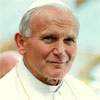
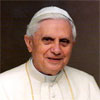

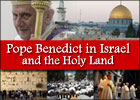



0 comments:
Post a Comment